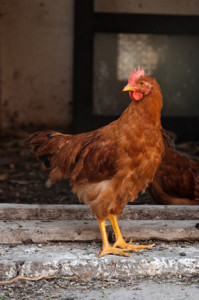 Molting is the process wherein hens lose feathers and grow new ones. It occurs naturally after 10 to 14 months of production, or it can be caused accidentally by temperature extremes, running out of feed or water, a decrease in light, or disease. Hens will not lay eggs during a molt. Molting gives birds a chance to rest. After seven to eight weeks, they will return to production for a second cycle, though they will not be as productive the second time around. However, they will often lay larger eggs than during their first cycle.
Molting is the process wherein hens lose feathers and grow new ones. It occurs naturally after 10 to 14 months of production, or it can be caused accidentally by temperature extremes, running out of feed or water, a decrease in light, or disease. Hens will not lay eggs during a molt. Molting gives birds a chance to rest. After seven to eight weeks, they will return to production for a second cycle, though they will not be as productive the second time around. However, they will often lay larger eggs than during their first cycle.
Chickens and Molting
February 16th, 2015Chicken Chat: Why do hens stop laying?
February 16th, 2015Here are some reasons why your hens may not be producing eggs.
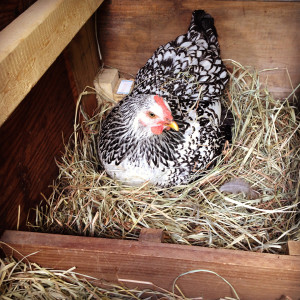 LIGHT:
LIGHT:
Many things can cause hens to stop laying eggs, but the primary reason is decreasing day length. Hens need a minimum of 17 hours of daylight to sustain strong production. If you don’t provide your hens with supplemental light, they will naturally stop laying eggs when daylight drops below 12 hours per day. Hens may also stop laying if light abruptly decreases by a few hours. This is a hormonal response regulated by a tiny gland that responds to changes in light. One 40-watt bulb per 100 square feet of coop space is enough to keep birds laying. Use an automatic timer to keep light and dark hours constant; just a day or two of too little light can end a laying cycle.
NUTRITION:
Inadequate nutrition is another reason hens stop laying and, surprisingly, the missing nutrient is often water. Hens need a constant source
of fresh water, and they do not like it very cold, so it is important to check and refresh waterers often in the winter. Cool water in the summer will help the birds combat the effects of heat. Never underestimate the importance or power of clean water at the right temperature!
Inadequate protein and/or energy can cause a production decrease. A shortage of dietary calcium will result in weaker eggshells and, eventually, weak bones as the hen robs her skeleton of calcium in an attempt to manufacture shells. Feeding too much “extra” feed, such as scratch grains or table scraps, can dilute and unbalance the complete nutrition in the hen‘s pellets or crumbles, thereby affecting her production and health. Hot weather will inhibit a hen‘s appetite, causing her to eat less and resulting in a drop in egg production on even the best diets. Offer a high-quality feed and severely limit table scraps and alternative feeds to obtain maximal egg production.
DISEASE:
Diseases and parasites will reduce a hen‘s productivity as well as her comfort. Build a relationship with a veterinarian who can help you establish a good flock health program. Never introduce new adult birds into your flock — apparently healthy adult birds can be carriers of a number of deadly diseases. Keep all premises as dry as possible to limit growth of coccidia, an insidious and stubborn parasite that flourishes in dampness causing coccidiosis.
AGE:
Egg production decreases with increasing age. Good hens will productively complete two egg-laying cycles of 50 to 60 weeks each. After that, production will drop off greatly.
STRESS:
Any kind of stress — extreme temperatures, excessive handling or moving, fright caused by predators, or noisy children (they’re all the same to a hen!) — will negatively affect egg production. Keep your hens’ environment as serene and comfortable as possible to help maintain health and productivity.
SECRECY:
Sometimes what appears to be a reduction in egg production is really the result of free-range hens hiding their eggs. Be sure you have enough nesting sites for the number of hens you are keeping, especially if you are allowing some to be “broody.” Make sure the nesting area is warm, comfortable, dimly lit and well-bedded with clean litter. Give the hens lots of good reasons to lay their eggs where you want them.
Source: Purina Poultry
7 Stock Show Preparation Tips
October 23rd, 2013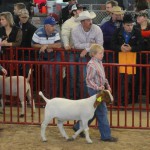 With the Ft. Worth, San Antonio, and Houston Stock Show’s around the corner, many student’s are working on with their animals as they prepare for the stock show season.
With the Ft. Worth, San Antonio, and Houston Stock Show’s around the corner, many student’s are working on with their animals as they prepare for the stock show season.
Here are seven tips to consider as you work with your animal.
Diet: Watch and control your animals diet. Inconsistent feeding can lead to problems in consumption and growth.
Always watch your animals diet. 45-30 days out from the show, look to see if your animal on track. Do they need to gain more weight, loose weight or do you need to hold them? The answers to these questions will help you determine if it’s time to cut back on feed, increase it or introduce supplements to their diet.
Coat Care: Your animals coat and skin condition are an important part of their show ring success. Know what the requirements are your animal and make sure they are clipped correctly.
Organization is key! Be prepared to answer questions the judges may ask you. Know your animal’s weight, breed & feed. Once at the show, know your schedule and class.
Showmanship: The time you spend working with your animal now will pay off in the show ring. Be prepared to answer questions on animal care, feeding strategies, weight, and breed. Dress appropriately and neat! Judges look at you as well as the animal. Nice shirts, clean jeans, and belts to hold up those pants. Be polite and respectful.
Judges: Each judge is different. Find out who the judge is, the information is available to you via the county extension office or the show rule book. Find out what is important to them. Understand their preferences, do your homework.
Be prepared: If you are traveling to an event consider putting together a check list for you and your animal. What do you need to bring with you and what should you do to get ready? When at the show, make a list of what you should do to prepare you and your animal. Keep all your equipment and show supplies together. A little preparation goes a long way in easing the stress for you and your animal.
Ask questions: The road to show ring success is long and requires discipline. You are bound to have a question along the way regarding care and feeding of your animal. Ask questions, it’s the best way to learn. Talk to your Ag teacher, local feed store or county agent, they are wealth of information and are happy to help.
State Fair of Texas
August 23rd, 2012 For more than 125 years, the State Fair of Texas has been one of the biggest events in the state! This year it runs September 28 – October 21 at Fair Park in Dallas. For more information and event details please visit the fair website.
For more than 125 years, the State Fair of Texas has been one of the biggest events in the state! This year it runs September 28 – October 21 at Fair Park in Dallas. For more information and event details please visit the fair website.
Show Chow Success: Cuatro Schauer
August 22nd, 2012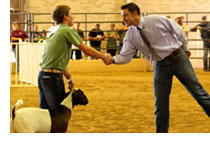 Recent high school graduate Cuatro Schauer shattered records with his prize winning steer at the Fort Worth Stock Show in February.
Recent high school graduate Cuatro Schauer shattered records with his prize winning steer at the Fort Worth Stock Show in February.
Cuatro’s cash cow, Spider Monkey, was auctioned off during the Sale of Champions for an astounding $230,000, making it the highest price paid in the shows 116-year history and beating the previous record of $210,000 set in 2010.
Cuatro, a recent graduate of A.C. Jones High School in Beeville, Texas, has been showing steers for nine years, goats for about seven and just recently started showing lambs as well.
“My uncle raises show steers, and he got me into it,” Cuatro said. “He got me my first steer and after that I was sold.”
Showing seems like a natural hobby for Cuatro with the Schauer family background. “My family owns a Purina Feed store that my dad took over in 1994, but my grandpa has been selling feed since 1969,” Cuatro said.
Cuatro attends about ten big shows a year and 15 to 20 prospect shows. Even before his big win at the Fort Worth Stock Show in February, he had some big wins under his belt. Cuatro won the Grand Champion Youth Market Goat at the State Fair of Texas in 2011, Grand Champion Junior Market Steer during the 2011 Rodeo Austin, the Grand Champion Lamb at the 2009 State Fair of Texas and the Reserve Grand Champion steer and medium wool lamb in the San Angelo Stock Show.
In addition to Cuatro’s success, the combination of the people he meets and his competitive drive keep him coming back every year.
“I’ve met a bunch of my really close friends through showing. You’ve got a kind of bond. Someone you meet at a show knows what you do and why you do it,” Cuatro said. “I like showing because you get to see everyone at the shows that you meet, but I am very competitive,” Cuatro said.
Cuatro will be going to Texas A & M this fall to major in Animal Science, along with many of his show friends. Until then he will continue to fill his days taking care of his animals and showing. When he has down time, Cuatro also enjoys golfing, fishing and hunting.
Cuatro is a dedicated customer of Honor® Show Chow® products because of their proven consistency and the results.
“It is one less thing you have to worry about when you go to feed the barn everyday,” Cuatro said.
Purina AntlerMax Technology Scores 561 B&C
August 19th, 2012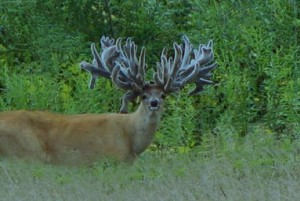 Wild Rivers Whitetails has been feeding Purina® AntlerMax® Diets exclusively on their farm since 2004. In 2011, they grew a deer named “Ballistic” that scored 561” Boone and Crockett. To the best of everyone’s knowledge, it was the highest scoring deer for the 2011 antler growing season.
Wild Rivers Whitetails has been feeding Purina® AntlerMax® Diets exclusively on their farm since 2004. In 2011, they grew a deer named “Ballistic” that scored 561” Boone and Crockett. To the best of everyone’s knowledge, it was the highest scoring deer for the 2011 antler growing season.
Purina® AntlerMax® Deer Chow contains our AntlerMax® Protein & Mineral Technology. It promotes antler growth by improving protein quality with ideal amounts and ratios of vitamins and minerals for optimal antler growth. Purina® AntlerMax® Deer Chow also helps milk production, milk quality and strong, healthy fawns with high survival rates.
Purina is proud to be a partner with Wild Rivers Whitetails located in Fence, Wisconsin. Gary Nelson, owner of Wild Rivers Whitetails, stated “There are 561 reasons why we feed Purina® AntlerMax® products to our deer, beginning with optimum nutrition, great customer service, and knowledgeable professional technical support.”
Texas Deer Hunting Regulations
July 24th, 2012Deer hunting in Texas is a popular pursuit, governed by the regulations set forth by the Texas Parks and Wildlife Department. Hunters have their choice of white-tailed deer or mule deer to hunt in the Lone Star State.
Licenses
Texas law requires that every deer hunter possess a license. Those younger than 17 must have a youth hunting license while those 17 and older must purchase a regular hunting license.
Types
There are various types of open seasons for both white-tailed deer and mule deer in Texas. There are seasons for taking these species with a bow, with a muzzleloader and with a rifle as well as seasons for antlerless and “spike” deer.
Identification
In Texas, the regulations define a “buck deer” as one that has a hardened antler sticking out of its skin on its head. A “spike deer” is one with antlers that have no more than a single point on them.
Limits
A deer hunter in Texas may bag as many as five white-tailed deer during the various seasons, but only three of them can be bucks. For mule deer, the combined seasons’ bag limit is two individual deer, with only one a buck.
Special Permit
The Texas Parks and Wildlife department can issue a “managed lands deer permit” to qualifying landowners. It allows hunters to exceed bag limits and enjoy an extended deer-hunting season. These hunters must have the permission of the landowner to hunt on the property.
Resources
http://www.tpwd.state.tx.us/huntwild/hunt/season/animal_listing/
http://www.tpwd.state.tx.us/huntwild/hunt/public/
http://www.tpwd.state.tx.us/learning/hunter_education/
Source: John Lindell, eHow Contributor
A Home for Every Horse Promotion!
July 17th, 2012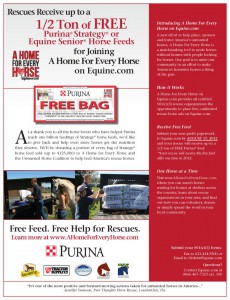 Help us share the news! Purina Horse feed giving away $125,000 of free feed to 501(c)(3) rescue shelters as part of A Home for Every Horse! This helpful flyer explains how rescues can take advantage of this donation. 501(c)(3) rescue shelters have until August 17, 2012 to email their 501(c)(3) forms to [email protected] or fax them to 623-434-9200.
Help us share the news! Purina Horse feed giving away $125,000 of free feed to 501(c)(3) rescue shelters as part of A Home for Every Horse! This helpful flyer explains how rescues can take advantage of this donation. 501(c)(3) rescue shelters have until August 17, 2012 to email their 501(c)(3) forms to [email protected] or fax them to 623-434-9200.
Your Invited to save $10!
July 16th, 2012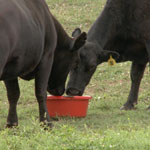 When it comes to your cattle starter program you can see the difference Purina Great Starts makes!
When it comes to your cattle starter program you can see the difference Purina Great Starts makes!
Come learn about the value of a Great Starts Cattle Feeding Program and SAVE $10 on your purchase of 10 bags or Tubs of Purina Cattle Starter Feeds.
Ask for your coupon in our store! Applicable with manufacturer’s coupon only.
Valid June 30-12/31, 2012.
Horse Q&A: Amount and Type of Feed
July 10th, 2012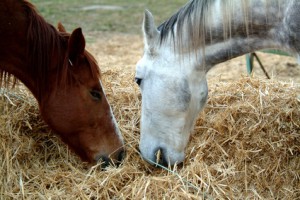 Am I feeding enough of the right type of feed?
Am I feeding enough of the right type of feed?
Since most people feed by the “scoop” rather than by weight, if is often easy to overestimate the amount of feed you are providing. Weighing out your feed will help. Additionally, be sure to consult the feeding directions on the back of the bag. Most feeds are formulated in such a way that a minimum feeding rate is required to provide for the nutrient and calorie requirements of a particular weight, lifestage and lifestyle. For example, you may be feeding your horse 5 year old 1000 lb. horse in light work one scoop of Strategy twice a day but he is losing weight. You decide to weigh out one scoop of Strategy and find that your scoop holds one pound of Strategy, therefore you have been feeding 2 lb./day total. Strategy is formulated to be fed at a minimum rate of 3-4 lb. /day to an adult 1000 lb. horse in light work in order to provide the basic nutrients and calories a horse of that description requires. So even though you thought you were providing an adequate amount of feed, it turns out that based on weight, you weren’t and you need to increase the volume fed.
Source: Purina Mills Equine Specialist


